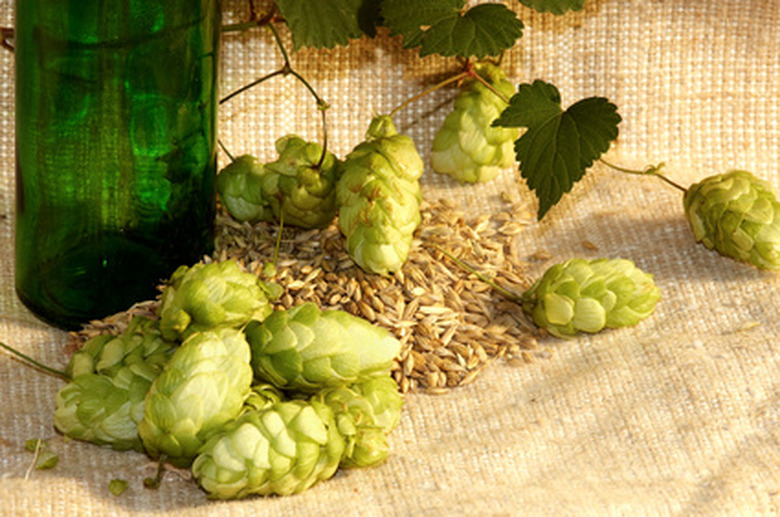Growing Hops In Texas
Things Needed
- Soil test kit
- Garden tiller
- Organic mulch
- Garden hose
- Sturdy timbers for trellis
- Twine
- Soaker hose
The state of Texas produces millions of barrels of beer annually. Many craft brewers and microbreweries, as well as home-brewers, grow their own hops (Humulus lupulus) locally. Hops produce an oily substance, known as lupulin, commonly used as a flavoring in beer. In addition to their usefulness in beer production, these tall vines add interest and greenery to yards and landscapes. With proper care, these vines often reach between 15 and 20 feet in height in Texas.
Step 1
Select an area that receives at least six hours of sunlight each day. Do not plant hops in low areas that collect and retain moisture after heavy Texas rainfalls. Check the area above your site to ensure adequate vertical space. Hops require trellises that are about 20 feet high.
- The state of Texas produces millions of barrels of beer annually.
- In addition to their usefulness in beer production, these tall vines add interest and greenery to yards and landscapes.
These perennials live for many years in favorable conditions. Texas soils vary greatly between areas of sandy soil, clay soil, and rich, humus soils. Much of Texas contains areas with slightly salty soils. Perform a soil test to determine the level of nutrients as well as the pH of your soil.
Step 2
Prepare the soil for your hops in the spring after the final frost in your area of Texas. Hops require deep, well-drained soils. Use a garden tiller to loosen the soil in your planting site to a depth of 8 to 10 inches. Purchase any soil additives and amendments recommended by the results of your soil test—hops prefer a soil pH between 6.0 and 7.0. Add recommended amendments to your tilled soil. Areas containing large amounts of Texas clay require the addition of organic mulches, such as compost or shredded bark. Work the additives into the loosened soil with your garden tiller. Place a strong, root-blocking barrier around the circumference of your planting site to contain the aggressive rhizomes.
- These perennials live for many years in favorable conditions.
- Use a garden tiller to loosen the soil in your planting site to a depth of 8 to 10 inches.
Step 3
Plant your hops in small hills. Make your rows 8 feet apart and pile the soil along the rows in small hills about 2 to 3 feet apart. Plant a couple of hop rhizomes in each hill. Place them 2 to 3 inches beneath the soil and pat down to firm the soil around the rhizomes. Thoroughly moisten the soil around the newly planted hops with your garden hose.
Step 4
Place a trellis along each row of hops. Use a commercial hop trellis, or make your own by placing tall timbers on both ends of each row; the trellis frame should be from 12 to 15 feet high when finished. Use weather-resistant landscaping posts or long timbers, at least 15 to 18 feet in length. Use an auger to dig postholes at least 3 feet deep at the ends of each row. Use a level to keep your posts straight. Pack the posts firmly in place with backfill or concrete. Cut lengths of 2-by-4s to attach horizontally between the tops of your vertical posts. The lengths of these pieces of wood will depend on the distance between your posts. Use strong screws or bolts to build the wooden frame of the trellis.
- Plant your hops in small hills.
- Use a commercial hop trellis, or make your own by placing tall timbers on both ends of each row; the trellis frame should be from 12 to 15 feet high when finished.
Tie a length of sturdy twine to the horizontal support above each of your vines. Allow the twine to reach all the way to the ground. As the shoots emerge and grow, wrap them gently around the suspended twine, encouraging them to adhere and grow along the twine. Once your vines reach the top of your trellis, allow them to spread sideways along the support.
Step 5
Set out a soaker hose in arid areas of Texas. Areas prone to droughts, such as northern and western Texas, require the regular use of a soaker hose to provide adequate levels of moisture for hop plants. Lay the soaker hose near the base of your vines and apply often enough to keep the soil slightly moist. These plants need about 1-1/2 inches of water each week.
- Tie a length of sturdy twine to the horizontal support above each of your vines.
- Lay the soaker hose near the base of your vines and apply often enough to keep the soil slightly moist.
Step 6
Harvest the cones from the vines when they feel light and dry to the touch. Check for a yellow color near the base of the cone petals. Pluck off the ripe cones for use in your home brewed beer, or allow these attractive cones to remain on the vine for their ornamental value. Prune your hop vines in the late fall or early winter. Use sharp pruning shears to remove all but the bottom 3 feet of each vine. Pull the cut segments from your trellis, leaving a clean support for the following year's growth. Remove the cut vegetation from the area to minimize the possibility of disease.
- Harvest the cones from the vines when they feel light and dry to the touch.
- Pull the cut segments from your trellis, leaving a clean support for the following year's growth.
References
- Texas A&M University: Preparing the Soil
- "The Self-Sufficient Gardener", John Seymour, 2005
- Merry Growlers of Davis: Homebrew Beer
- Window on State Government: Craft Brewing in Texas
